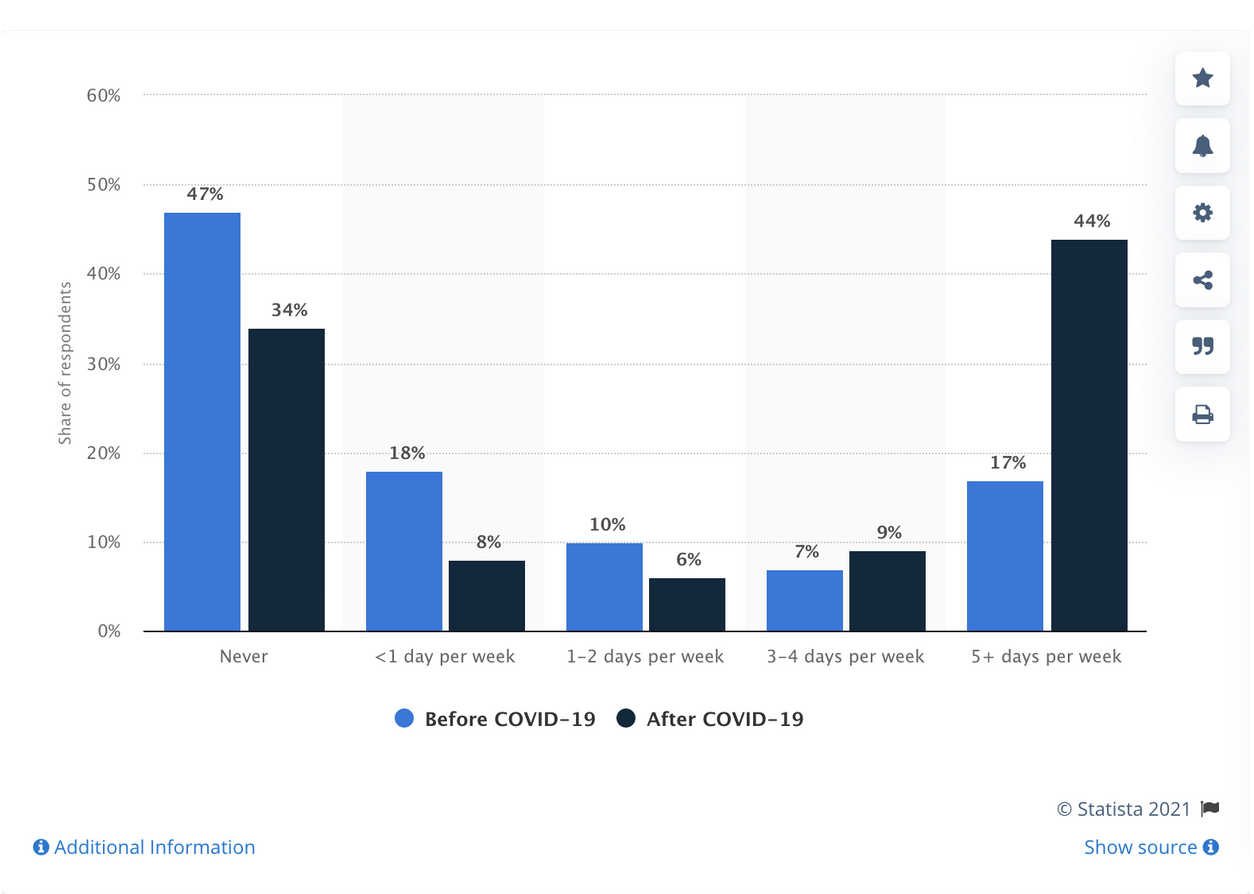It’s undeniable that we have been living through unprecedented times. And as we move forward, we will do so with lessons learned, especially when it comes to where work happens. As the vice president of advisory in the Gartner HR practice, Elisabeth Joyce, said recently “The COVID-19 pandemic brought about a huge experiment in widespread remote working.”
And it has proven itself to be successful, as 58.6% of the workforce is now remote, and 16% of businesses across the world are fully remote, according to an Owl Labs study. This is of no surprise to Gartner who stated “As business leaders plan and execute reopening of their workplaces, they are evaluating more permanent remote working arrangements as a way to meet employee expectations and to build more resilient business operations.”
As you can see in the chart above by Statista, prior to COVID-19, 17% of survey participants reported working from home 5 days a week, and 47% never worked from home. Now, 44% of people are reporting that they work from home 5 days a week and only 34% never work from home.
Remote work is expected to be a large portion of businesses reopening plans and for good reason. Aside from the obvious health protocols, remote work has proven to increase employee retention and improve mental health, both of which are huge wins for businesses.
28 Remote Work Statistics To Know
- 88% of the organizations across the globe made it mandatory or encouraged their employees to work from home after COVID-19 was officially labeled a pandemic. (Gartner)
- The number of people who work from home has risen by 159% since 2009 (Global Workplace Analytics)
- 73% percent of executives surveyed by PwC believe that working remotely has been a success (PwC)
- 61.9% of the companies are planning more remote work now and in the years to come. (Upwork)
- Executives expect to have 30% fewer square feet of office space (PwC)
- 55% of businesses globally offer some capacity for remote work (Review42)
- Facebook CEO expects 50% of the workforce within the company to be remote by 2030 (NBCNews)
- As early as 2028, 73% of all departments are expected to have remote workers (Upwork)
- 22% (36.2 Million) of Americans will be working remotely by the year 2025, an 87% increase from pre-pandemic levels (PwC)
- By the end of 2021 25-30% of the workforce will work from home for several days a week. (Global Workplace Analytics)
- As much as 56% of full-time employees could work from home if their employers allowed it (Global Workplace Analytics)
- 62% of employees expect their employers to allow them to work remotely moving forward (Intuition)
- 99% of people would choose to work remotely for the rest of their life, even if it was just part-time (Buffer)
- 72% of employees prefer a hybrid remote-office model with only 12% preferring to always work in an office setting. (PwC)
- Remote work has risen by 173% in the U.S. between 2005 and 2018 (Global Workplace Analytics)
- 32% of survey respondents said they would like to work from home permanently. (PwC)
- 83% of employers believe the switch to remote work has proven successful for their company. (PwC)
- Of employees aged 22-65, 62% say they work remotely occasionally (Owl Labs)
- 55% of institutions across the globe offer remote work in some capacity. (CyberReef)
- The majority (77%) of telecommuters report being more productive when working from home. (CyberReef)
- 99% of those currently telecommuting state they want to continue telecommuting in the future.
- 90% of remote workers would recommend working remotely to a friend. (CyberReef)
- 4.7 million workers were already working from home before COVID-19 changed everything. (CyberReef)
- Almost 2 out of every 10 people work from home permanently. (PwC)
- The majority of businesses (56%) allow remote work across the world, with 44% reporting no option for working from home.
- 68% of employees across the globe work remotely once a month, 52% once a week. (Owl Labs)
- 18% of employees work remotely full-time (Owl Labs)
- 3.9 million American employees spend the majority of their days working remotely. (Flexjobs)
Make No Mistake, Remote Work is Here to Stay
Moving forward, it’s clear that the new normal of work will include some form of remote work for the majority of businesses. And where possible, this strategy can prove to be the difference between gaining the competitive edge…and not. And unified communications will be crucial to effectively transition your business and your employees from when they are in the office to when they are working remotely – and with no disruption on the continuity of service to your customers. Learn more about how Unified Communications can help your business with your remote work strategy.









